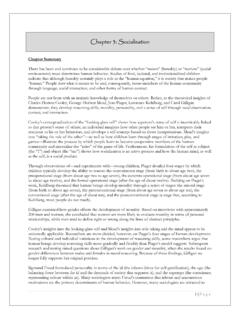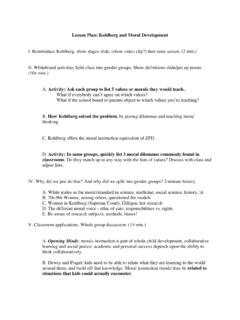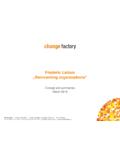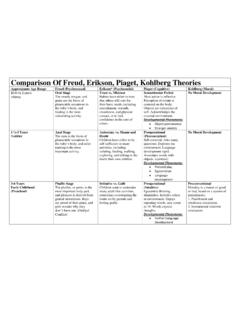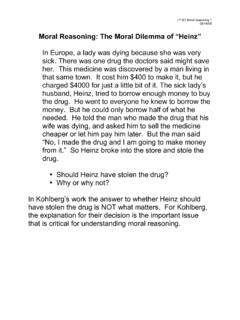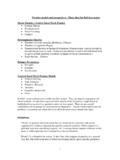Transcription of 7. Piaget, Kohlberg, Gilligan, and Others on Moral …
1 7-1 7. piaget , kohlberg , gilligan , and Others on Moral Development Copyright 2005, 2006 J. S. Fleming, PhD _____ When confronted with a group of parents who asked me How can we help make our children virtuous? I had to answer as Socrates, You must think I am very fortunate to know how virtue is acquired. The fact is that far from knowing whether it can be taught, I have no idea what virtue really is.. It appears, then, that we must either be totally silent about Moral education or else speak to the nature of virtue. Lawrence Kohlberg1 _____ I. piaget on Moral Development piaget s Methods for Studying Moral Development piaget believed that observing children playing games and querying them about the rules provided a realistic lab on life for understanding how morality principles develop.
2 In his book The Moral Judgment of the Child ( piaget , 1932/1962), he studied children playing the game of marbles. The fact that only boys played this game seemed to impose a limitation on the generality of his findings, so he also studied a girl s game called let cachant, a kind of primitive hide-and-seek. But his most important observations were made on the boys a fact that incurred later criticism, as will be seen shortly. piaget often used a practiced technique of feigned naivety: He pretended to be ignorant of the rules of the games and asked the children to explain them to him. In this way he was able to comprehend the way that the children themselves understood the rules, and to observe as well how children of different ages related to the rules and the game.
3 On first thought it might seem odd that piaget believed he could learn all important aspects of Moral development by observing children s play. But as Ginsburg and Opper (1988, p. 96) note, On closer inspection it would seem as if the rules 7-2 governing the game of marbles fulfill all the defining conditions of a Moral system. The rules control how individuals behave toward one another in terms of the actions which comprise the game, they determine individual and property rights, and they are a cultural product which has been passed down from generation to generation .. The rules have been developed largely by children. Therefore, the child s conception of the game .. is subject to little adult influence.
4 (As an interesting side note it should be mentioned that studying game strategies to learn about behavior and morality is now very much an accepted part of research in psychology and economics. Game theory can be used to simulate competitive or cooperative conditions in which either selfish strategies benefit only the individual, or cooperative strategies can mutually benefit all parties, as in Robert Trivers (1971) studies of reciprocal altruism see Robert Wright s, 1994, The Moral Animal for other game theoretical studies of human behavior. Here is another instance in which piaget seemed ahead of his time!) A second technique used by piaget in studying Moral understanding was to relate a short story or scenario that described some form of misbehavior by a child or by an adult.
5 He then presented the children with possible corrective actions that might be meted out to the offender and asked the children to tell him which were fair and just and which were not, and why. If a child neglects a chore, for example, after repeated requests, what is an appropriate punishment or correction? Here piaget distinguished between expiation (atonement) and reciprocity as punishment strategies. Expiation meant that some form of punitive action ( , spanking; confinement) would be invoked in which the offender must pay the price for the offense. In contrast, reciprocity implies setting things right. With reciprocity the child must be made to see the consequences of his or her neglect, and to clearly understand the need to behave in a more cooperative manner.
6 piaget s Stages of Moral Development Children s Understanding of Rules. piaget observed four stages in the child s development of Moral understanding of rules, based largely on his observation of children s games: 7-3 The first stage characterizes the sensorimotor period of development (children under four years) in which the child merely handles the marbles in terms of his existing motor schemes. Play is purely an individual endeavor, and .. one can talk only of motor rules and not of truly collective rules ( piaget , 1932/1962, p. 27, emphasis added). In the second stage, about ages four to seven, game playing is egocentric; children don t understand rules very well, or they make them up as they go along.
7 There is neither a strong sense of cooperation nor of competition. Recalling from Chapter 4 that egocentric children at the preoperational stage seem to have collective monologues rather than true dialogs, these observations do not seem surprising. The third stage, at about ages seven to ten or eleven, is characterized by incipient cooperation. Interactions are more social, and rules are mastered and observed. Social interactions become more formalized as regards rules of the game. The child learns and understands both cooperative and competitive behavior. But one child s understanding of rules may still differ from the next, thus mutual understanding still tends to be incomplete. In the fourth stage, beginning at about age eleven or twelve, cooperation is more earnest and the child comes to understand rules in a more legalistic fashion.
8 piaget calls this the stage of genuine cooperation in which .. the older child shows a kind of legalistic fascination with the rules. He enjoys settling differences of opinion concerning the rules, inventing new rules, and elaborating on them. He even tries to anticipate all the possible contingencies that may arise (Ginsburg & Opper, 1988, p. 98). But in terms of cognitive development this stage overlaps piaget s formal operational stage; thus here the concern with abstraction and possibility enters the child s imagination. 7-4 Children s Moral Judgments. piaget s studies of Moral judgments are based both on children s judgments of Moral scenarios and on their interactions in game playing. In terms of Moral judgments, piaget found that younger children (around ages four to seven) thought in terms of Moral realism (compare to realism in Chapter 4) or Moral heteronomy.
9 These terms connote an absolutism, in which morality is seen in terms of rules that are fixed and unchangeable (heteronomy means from without ). Guilt is determined by the extent of violation of rules rather than by intention. piaget s Method: Sample Dialog Between a Researcher and a Child The following dialog is revealing (from piaget , 1932/1962, pp. 124-125): Q: Is one of the boys [who broke teacups] naughtier than the other ? A: The first is because he knocked over twelve cups. Q: If you were the daddy, which one would you punish most? A: The one who broke twelve cups. Q: Why did he break them? A: The door shut too hard and knocked them. He didn t do it on purpose. Q: And why did the other boy break a cup? A: He wanted to get the jam.
10 He moved too far. The cup got broken. Q: Why did he want to get the jam? A: Because he was all alone. Because his mother wasn t there. Q: Have you got a brother? A: No, a little sister. Q: Well, if it was you who had broken the twelve cups when you went into the room and your little sister who had broken one cup when she was trying to get the jam, which of you would be 7-5 punished more severely? A: Me, because I broke more than one cup. Clearly this child understand that the boy who broke twelve cups did not do this intentionally, yet he still claims that this boy was more guilty (deserved greater punishment) than the one who broke just a single cup while doing something he wasn t supposed to be doing. Older children and adults find his idea of justice perplexing.










